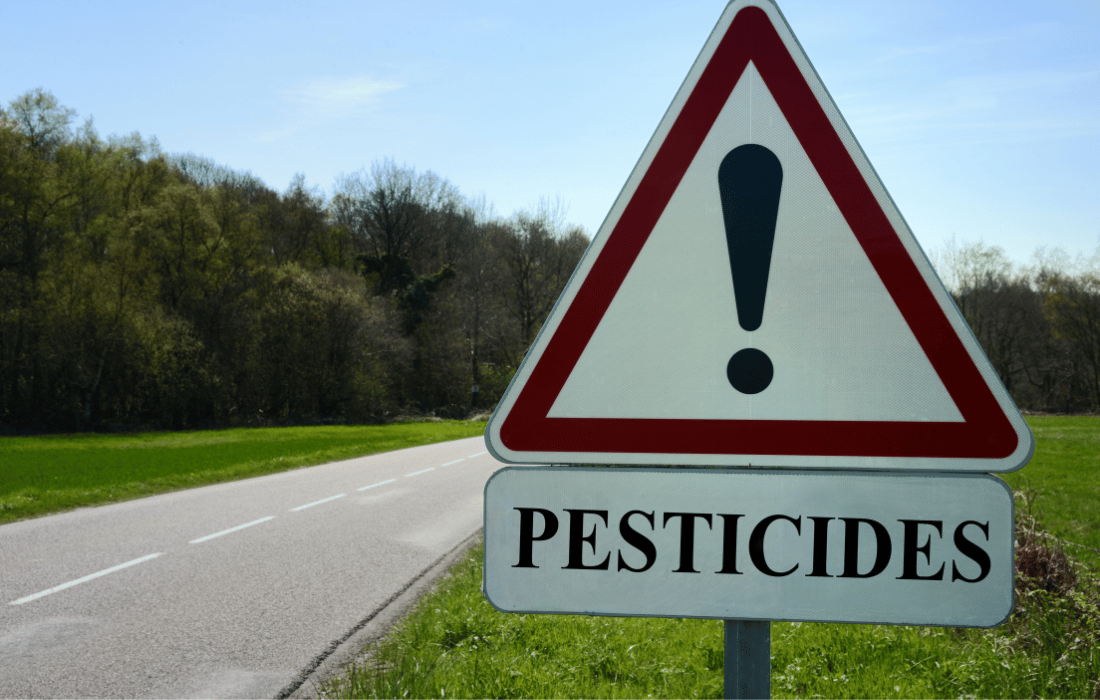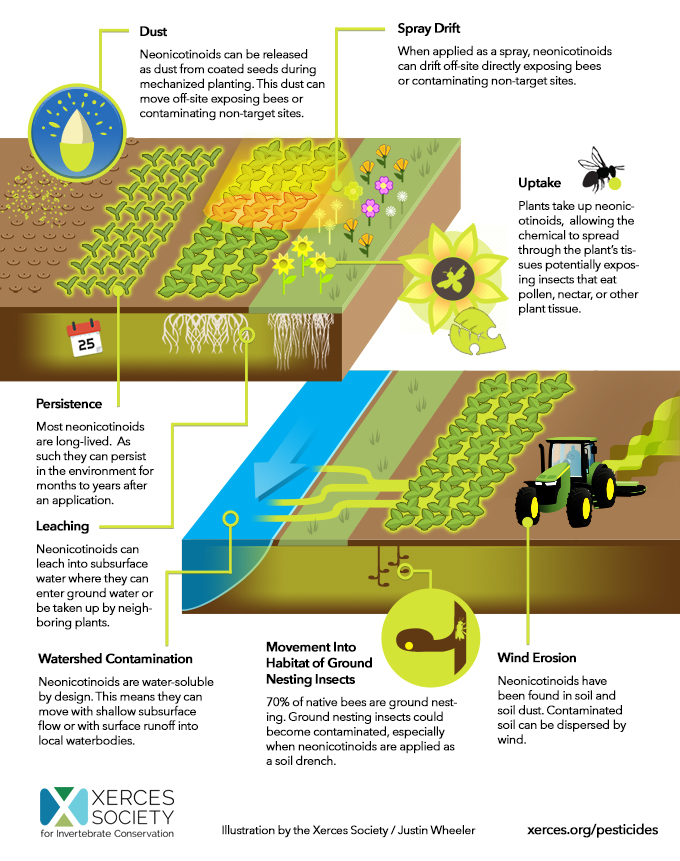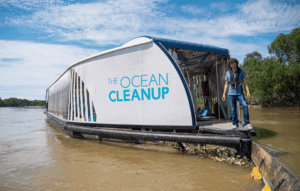In the quiet expanse of our fields and the gentle flow of our rivers, an insidious battle rages—one where the weapons are not swords or spears but chemicals that seep into the very veins of our planet. Neonicotinoids, or “neonics” as they’re commonly called, are at the forefront of this conflict. Touted for their effectiveness in pest control, these pesticides have become a double-edged sword, slashing through pest populations while simultaneously cutting into the fabric of our ecosystems, soil health, and even our own well-being. As someone who stands firmly against the rampant use of pesticides, I invite you to explore the complexities and risks embedded within this modern agricultural dilemma.
Neonicotinoids were introduced to the market with the promise of reducing the need for broad-spectrum insecticides, targeting pests with precision. However, the narrative has shifted as we’ve uncovered the unintended consequences of their widespread application. This article delves into the nuanced landscape of neonicotinoid use, highlighting the environmental and health risks, and advocating for sustainable alternatives that align with the health of our ecosystems and communities.
Neonics in Minnesota’s Waters: The Underwater Threat
Minnesota’s waterways, once a symbol of natural splendor, are now facing a stealthy adversary in the form of neonicotinoid pesticides. According to a comprehensive report by the Natural Resources Defense Council (NRDC), an astonishing 95% of these water bodies are contaminated with at least one type of neonic, and 87% are grappling with a cocktail of two or more.
This contamination largely stems from agricultural activities, where neonics are applied as coatings on corn and soybean seeds.
The Hard Facts:
- Neonicotinoids, used for pest control, are leaking into Minnesota’s rivers, lakes, and wetlands mainly through runoff from treated farm fields.
- The Minnesota Department of Agriculture (MDA) has flagged clothianidin and imidacloprid as significant concerns, promoting better management practices to curb this environmental issue.
- There’s a pushback against regulation, with fears that restricting these chemicals might lead to a return to less effective or more harmful pest control methods.
In a Nutshell:
Neonics don’t just vanish; they’re soluble in water, which means they can easily escape into our aquatic environments. This leads to:
- Aquatic Life at Risk: The very foundation of our water ecosystems is threatened, with insects like mayflies and dragonflies facing severe impacts.
- Bioaccumulation Danger: These chemicals can accumulate in the food chain, potentially harming fish, birds, and even us.
Key Points to Consider:
- Concentrations of neonics in water can be hazardous, well above what’s considered safe for aquatic organisms.
- The contamination isn’t confined to farmland; it reaches urban areas and natural reserves, raising alarms about drinking water quality.
- There’s an urgent need to address this, especially in rural areas where private wells could be contaminated.
Grassroots Echoes:
Neonics in our lakes are turning them into chemical dumps. It’s time for sustainable farming practices that don’t compromise our water’s purity.
Every raindrop could be carrying neonics into our streams. We must rethink how we farm to protect our waters.
Advocacy for Change:
Environmental advocates are calling for tighter controls or outright bans on these pesticides in sensitive areas. There’s a growing movement towards organic and regenerative farming, which could offer sustainable alternatives to chemical pest management. Community-led initiatives are educating people on the risks and encouraging local water testing and transparency of findings.
The Ecological Toll of Pest Control
Impact on Pollinators: A Silent Decline
Neonicotinoids are systemic, meaning they integrate into the plant’s system, from roots to leaves, nectar, and pollen—where bees and other pollinators gather their sustenance. The science is clear: neonics lead to direct toxicity, sub-lethal effects like impaired foraging and memory, contribute to population declines, and cause long-term stress to pollinators.
Research has shown that exposure to neonics can lead to significant changes in bee behavior, including a reduced ability to navigate back to their hives, which can deplete colony numbers over time. Bumblebee colonies exposed to field-realistic doses of neonics have shown reduced growth and a lower production of queens, which are vital for the next generation of bees. This decline in pollinator populations isn’t just a blow to biodiversity; it has tangible effects on crop production and, thus, food security.
Soil Health Under Siege: The Hidden Crisis
The soil beneath our feet, teeming with life, is no less at risk. Neonics disrupt the microbial diversity essential for soil vitality, affect vital soil biota like earthworms, and persist in the soil, challenging the very foundation of sustainable agriculture.
Soil microorganisms play a critical role in nutrient cycling, decomposition, and maintaining soil structure. When this balance is disturbed by pesticides, the soil’s ability to support plant life diminishes. Earthworms, which aerate and enrich the soil, are particularly sensitive to neonicotinoids, with studies showing reduced populations in treated areas. The persistence of these chemicals in soil can lead to long-term degradation of soil quality, reducing its capacity to sequester carbon and support agricultural productivity.
Wider Impact on Biodiversity
One 2023 review highlights that neonicotinoids are frequently detected in various environmental compartments, leading to exposure and contamination of non-target organisms. This study confirms the negative effects on terrestrial invertebrates like pollinators and natural enemies, extending the known negative impacts beyond bees to include a broader spectrum of insect life.
The Environmental Risks of Neonicotinoids Post-2013: A Comprehensive Review
- Environmental Dispersion: Only a small fraction of neonicotinoids applied to seeds is absorbed by crops, with the majority dispersing into the environment, leading to chronic exposure for wildlife, especially pollinators.
- Contamination Pathways: Neonics are found across various environmental matrices – soil, water, air, and now, with recent studies, even in coastal and marine environments. Their presence in transitional ecosystems like lagoons and estuaries signals a broader threat to marine biodiversity.
- Biodiversity Loss: The 2023 review underscores the direct impacts on terrestrial and aquatic life, emphasizing the need for more research on indirect effects like trophic cascades where changes in one species affect others through food webs.
Impact on Human Health: A Closer Look
- Chronic Exposure Concerns: There’s a growing body of evidence suggesting links between chronic exposure to neonicotinoids and developmental disorders, including autism spectrum disorder, anencephaly, and Tetralogy of Fallot in children.
- Neurological Implications: Designed to target insect nervous systems, neonics’ neurotoxic properties raise questions about their effects on human cognitive function and development, even at low, environmental exposure levels.
- Need for Further Research: While acute poisoning cases are rare, the potential for widespread, subtle health effects due to environmental contamination, as echoed by the 2023 environmental impact study, calls for more comprehensive research to understand these pesticides’ full human health impact.
The Dilemma of Regulation and Resistance
Current Events, MAHA, and the Push for Change

The War Against Corruption and the Path to Sustainability:
Economically, the reliance on pesticides is shortsighted. The real costs are seen in health crises and environmental degradation. Transitioning to integrated pest management and supporting sustainable farming practices could not only restore our land but also our collective well-being.
The Organic Advantage: Quality Over Quantity
Organic farming offers a beacon of hope. By avoiding synthetic pesticides, it supports biodiversity, enhances soil health, and potentially reduces human health risks. The economic advantages are notable, with organic products often commanding higher prices in the market Xerces Society Organic Farming Research Foundation.
Organic practices involve using natural pest deterrents, promoting a rich diversity of plant life, and maintaining soil health through natural means. Studies have shown that while there might be a transition period with lower yields, the long-term benefits include improved soil fertility, biodiversity, and resilience to pests and diseases without the environmental toll of synthetic pesticides.
Regenerative Agriculture: Back to Respecting the Land
Regenerative agriculture goes further, aiming to rejuvenate the land through practices like no-till farming and integrating livestock. It’s about creating a symbiotic relationship with nature, fostering biodiversity, and improving economic resilience Frontiers in Sustainable Food Systems Nature Sustainability.
Regenerative methods focus on soil health as the key to sustainable food production. By covering the soil year-round, reducing mechanical disturbance, and using livestock to cycle nutrients, farmers can build up organic matter, sequester carbon, and enhance water retention. This approach not only mitigates climate change but also makes farms more resilient to drought and floods, potentially increasing profitability through reduced input costs and improved soil health.
Organic Pest Management: A Return to Wisdom
The art of organic pest management lies in understanding nature’s balance. Biological control, cultural practices, and physical methods offer effective, sustainable alternatives to chemical warfare, embracing the wisdom of natural systems.
Biological Control Journal of Sustainable Agriculture
- Biological Control: Encouraging natural predators like ladybugs or birds to control pest populations.
- Cultural Practices: Crop rotation, intercropping, and timing of planting to disrupt pest life cycles.
- Physical and Mechanical Methods: Using barriers, traps, or manual removal of pests.
These methods require a deeper understanding of local ecosystems and can be more labor-intensive but ultimately foster an environment where pest pressure is naturally managed, reducing reliance on chemicals.
Conclusion: A Call for Change
The narrative of neonicotinoids is more than just a tale of agricultural advancement; it’s a wake-up call for a shift in how we perceive and interact with our environment. The risks to pollinators, soil health, aquatic life, and human health are too significant to ignore. As someone opposed to the use of such pesticides, I advocate for a transition to organic and regenerative practices, not only for the sake of our planet but for the health and well-being of future generations.
We must embrace this change not with fear but with an understanding that sustainable agriculture can be both economically viable and ecologically sound. The conversation around pesticides must evolve from acceptance to critical analysis, from reliance to innovation. Let’s heed the signs our environment is showing us and move towards a future where our food systems nourish both people and the planet.









